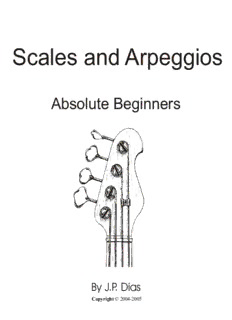
Scales and Arpeggios by JP Dias PDF
Preview Scales and Arpeggios by JP Dias
Scales and Arpeggios Absolute Beginners By J.P. Dias Copyright © 2004-2005 To Paula Contents Introduction................................................8 1. Basic of Reading Music.........................9 2. Major Modes........................................10 4. Minor Scales........................................24 3. Pentatonic Scales................................30 5. Symmetrical Diminished............................32 6. Triads...................................................37 7. Arpeggios.............................................38 Introduction The purpose of this book is to help beginner bassist to find the easiest way to play scales, triads and arpeggios. All the examples are written in the key of C in order to make easer the scale comparison. Most scales can be played in more than two positions, so that I would suggest to find all possible roots and play the same fingering showed, also play them in different keys. This book is not intended to be a method and I strongly recommend to find a qualified teacher to help you assimilate the information on this book. Have Fun 8 Basics of Reading Music The fundamentals of music are pitch and rhythm which are placed in a grid of five lines and four spaces called Staff. Bass Players Read Bass Clef. The symbol of the Bass Clef is derived from the old German way of writing “F”. The two dots on the right of the bass clef symbol surround the line on which “F” pitch is written. The notes above are all natural however any of this notes can be raised or lowered a half step by placing a accidental, sharp ((cid:35)) or flat ((cid:98)) right before it. When an accidental occurs, it applies to the whole measure unless it is cancelled out with another accidental. Sharp ((cid:35)) Raises a note one half step. Flat ((cid:98)) Lowers a notes one half step. Natural () Cancells an accidental previously used. (cid:110) (cid:35)(cid:32) (cid:98) (cid:35)(cid:32) (cid:98) (cid:35)(cid:32) (cid:98) (cid:35)(cid:32) (cid:98) (cid:35)(cid:32) (cid:98) (cid:35)(cid:32) (cid:98) (cid:35)(cid:32) (cid:98) (cid:35)(cid:32) (cid:98) (cid:35)(cid:32) (cid:98) F / G G / A A / B C / D D / E F / G G / A A / B C / D Note: The distance between B and C and E and F is a half step, that’s way there's no (cid:35) or (cid:98)(cid:32) in between those notes. J.P. Dias’s Scales & Arpeggios 9 Major Modes C Ionian Scale Fingering Scale Triad Arpeggio C Ionian C Cmaj7 33rrdd FFrreett 33rrdd FFrreett 33rrdd FFrreett C Ionian C Cmaj7 88tthh FFrreett 88tthh FFrreett 88tthh FFrreett 10 J.P. Dias’s Scales & Arpeggios C Ionian Scale (Imaj7) Exercise 1 Exercise 2 Exercise 3 Exercise 4 Exercise 5 J.P. Dias’s Scales & Arpeggios 11 Major Modes D Dorian Scale Fingering Scale Triad Arpeggio D Dorian Dm Dm7 5th Fret 5th Fret 5th Fret D Dorian Dm Dm7 10th Fret 10th Fret 10th Fret 12 J.P. Dias’s Scales & Arpeggios D Dorian Scale (IIm7) Exercise 1 Exercise 2 Exercise 3 Exercise 4 Exercise 5 J.P. Dias’s Scales & Arpeggios 13 Major Modes E Phrygian Scale Fingering Scale Triad Arpeggio E Phrygian Em Em7 7th Fret 7th Fret 7th Fret E Phrygian Em Em7 12th Fret* 12th Fret* 12th Fret* *This Scale, Triad and Arpeggio could be played one 8va Lower Starting from E open String 14 J.P. Dias’s Scales & Arpeggios
Description: